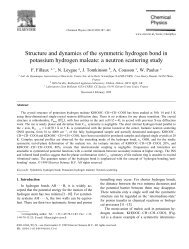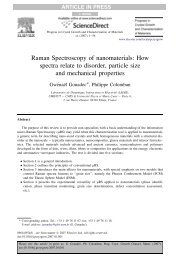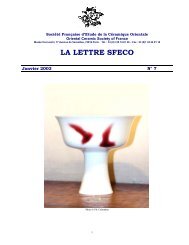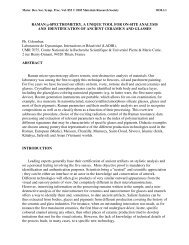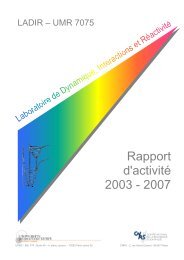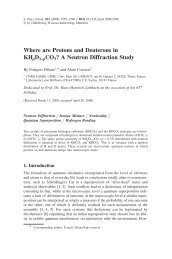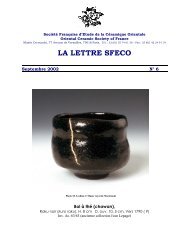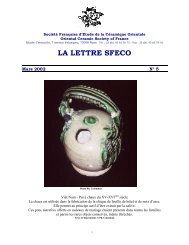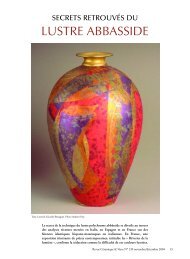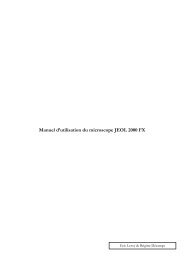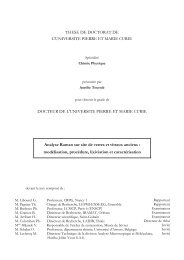12 Nano/microstructure - institut de chimie et des materiaux paris-est
12 Nano/microstructure - institut de chimie et des materiaux paris-est
12 Nano/microstructure - institut de chimie et des materiaux paris-est
- No tags were found...
You also want an ePaper? Increase the reach of your titles
YUMPU automatically turns print PDFs into web optimized ePapers that Google loves.
DK4027_book.fm Page 322 Monday, May 16, 2005 2:01 PM322 Chemical Processing of Ceramics, Second EditionAlloying the materials obtained from liquid precursors offers a new route tocreate particular micro/nanostructures in or<strong>de</strong>r to optimize the properties ofporous materials.E. FUNCTIONALLY GRADED MATERIALSBy selecting the appropriate sol-gel precursors, the dwell temperature requiredto achieve maximum <strong>de</strong>nsification can be raised or lowered by about 100°C. 1,36This makes it possible to combine several kinds of impregnated fiber/matrixinterphases in the same composite in or<strong>de</strong>r to tailor its physical and/or chemicalproperties for a particular application. Composites have been fabricated thatcombine various kinds of woven fibers (SiC Nicalon ® , Nextel ® , Almax ® ,Saphikon ® ) with various kinds of matrices (LAS, mullite [a pure dielectric witha real microwave permittivity close to 5 at 10 GHz], Nasicon [a solid electrolytewith the structural formula Na 1+x Zr 2 Si x P 3x O <strong>12</strong> (0 x 3) offers the advantage of anelectrical conductivity varying by four or<strong>de</strong>rs of magnitu<strong>de</strong> as a function of x],celsian [a corrosion-resistant ceramic], zirconia) 6–10,76,78,79,86,87 in or<strong>de</strong>r to tailorthermomechanical and electromagn<strong>et</strong>ic properties simultaneously.The processing can be summarized as follows: The fibers of a two-dimensionalwoven fabric are first impregnated with a liquid alkoxi<strong>de</strong> mixture, whichfills the voids b<strong>et</strong>ween the fibers, transforms in situ into a gel by reaction withatmospheric moisture, and will be converted into a (glass)-ceramic by pyrolysisduring the hot-pressing of prepreg fabrics covered with the matrix pow<strong>de</strong>r precursors.Depending on both the matrix and the fibers, several different “interfaceprecursors” can be used, either alone or in various combinations. Finally, thedoubly impregnated, coated woven fabrics are stacked in a graphite mold andhot-pressed, typically b<strong>et</strong>ween 950 and 1400°C. By selecting the appropriate solgelprecursors, the dwell temperature required to achieve maximum <strong>de</strong>nsificationcan be raised or lowered by about 100°C. This makes it possible to combineseveral kinds of fiber-reinforced layers in the same composites in or<strong>de</strong>r to tailor,unidirectionally, the microwave absorption along the direction perpendicular tothe body. Examples given in Figure <strong>12</strong>.<strong>12</strong> show (1) a composite consisting of azirconia matrix and a mullite matrix, both reinforced by SiC Nicalon NLM 202fibers (4 + 4 layers), and (2) NASICON matrix composite reinforced on one si<strong>de</strong>by low-permittivity Nextel mullite woven fibers (4 layers) and on the other si<strong>de</strong>by conducting Nicalon SiC woven fibers (2 layers).V. CHARACTERIZATION OF MULTIPHASEMATERIALSOne of the difficulties in the characterization of multiphase materials is the needto analyze the different phases at various scales: at the scale of each phase, atthe scale of their association (interfaces and intrafaces), and at the scale of theparts. We will address two m<strong>et</strong>hods, which can be used very rapidly for this type



